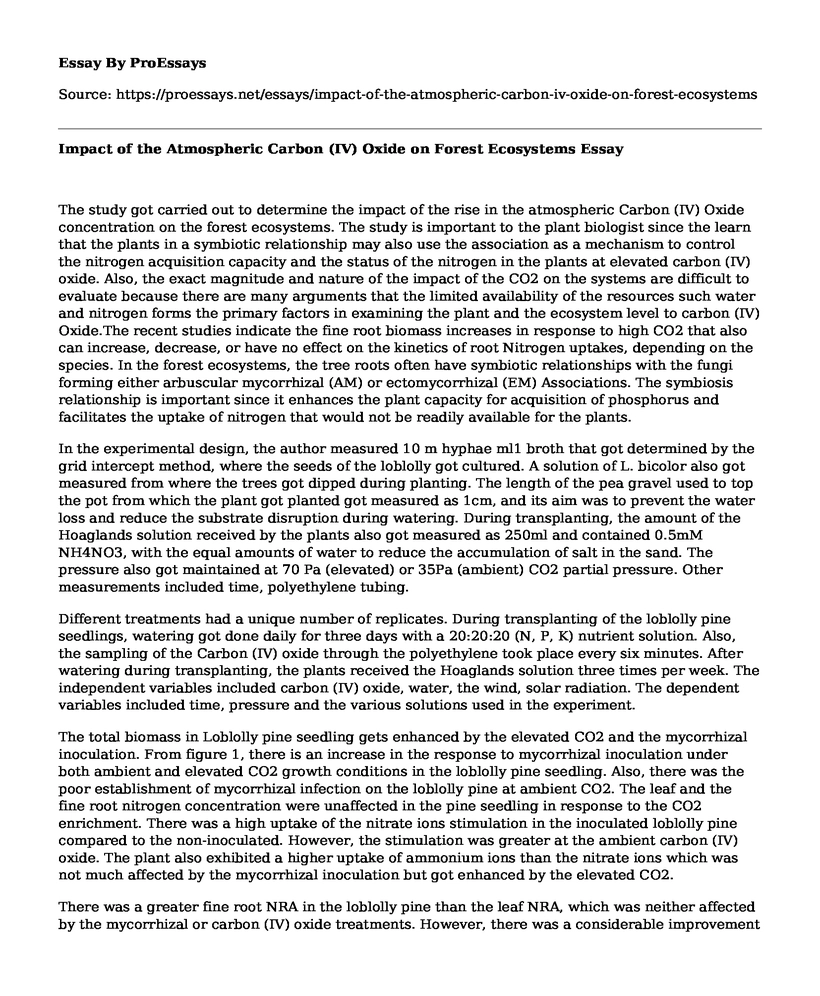The study got carried out to determine the impact of the rise in the atmospheric Carbon (IV) Oxide concentration on the forest ecosystems. The study is important to the plant biologist since the learn that the plants in a symbiotic relationship may also use the association as a mechanism to control the nitrogen acquisition capacity and the status of the nitrogen in the plants at elevated carbon (IV) oxide. Also, the exact magnitude and nature of the impact of the CO2 on the systems are difficult to evaluate because there are many arguments that the limited availability of the resources such water and nitrogen forms the primary factors in examining the plant and the ecosystem level to carbon (IV) Oxide.The recent studies indicate the fine root biomass increases in response to high CO2 that also can increase, decrease, or have no effect on the kinetics of root Nitrogen uptakes, depending on the species. In the forest ecosystems, the tree roots often have symbiotic relationships with the fungi forming either arbuscular mycorrhizal (AM) or ectomycorrhizal (EM) Associations. The symbiosis relationship is important since it enhances the plant capacity for acquisition of phosphorus and facilitates the uptake of nitrogen that would not be readily available for the plants.
In the experimental design, the author measured 10 m hyphae ml1 broth that got determined by the grid intercept method, where the seeds of the loblolly got cultured. A solution of L. bicolor also got measured from where the trees got dipped during planting. The length of the pea gravel used to top the pot from which the plant got planted got measured as 1cm, and its aim was to prevent the water loss and reduce the substrate disruption during watering. During transplanting, the amount of the Hoaglands solution received by the plants also got measured as 250ml and contained 0.5mM NH4NO3, with the equal amounts of water to reduce the accumulation of salt in the sand. The pressure also got maintained at 70 Pa (elevated) or 35Pa (ambient) CO2 partial pressure. Other measurements included time, polyethylene tubing.
Different treatments had a unique number of replicates. During transplanting of the loblolly pine seedlings, watering got done daily for three days with a 20:20:20 (N, P, K) nutrient solution. Also, the sampling of the Carbon (IV) oxide through the polyethylene took place every six minutes. After watering during transplanting, the plants received the Hoaglands solution three times per week. The independent variables included carbon (IV) oxide, water, the wind, solar radiation. The dependent variables included time, pressure and the various solutions used in the experiment.
The total biomass in Loblolly pine seedling gets enhanced by the elevated CO2 and the mycorrhizal inoculation. From figure 1, there is an increase in the response to mycorrhizal inoculation under both ambient and elevated CO2 growth conditions in the loblolly pine seedling. Also, there was the poor establishment of mycorrhizal infection on the loblolly pine at ambient CO2. The leaf and the fine root nitrogen concentration were unaffected in the pine seedling in response to the CO2 enrichment. There was a high uptake of the nitrate ions stimulation in the inoculated loblolly pine compared to the non-inoculated. However, the stimulation was greater at the ambient carbon (IV) oxide. The plant also exhibited a higher uptake of ammonium ions than the nitrate ions which was not much affected by the mycorrhizal inoculation but got enhanced by the elevated CO2.
There was a greater fine root NRA in the loblolly pine than the leaf NRA, which was neither affected by the mycorrhizal or carbon (IV) oxide treatments. However, there was a considerable improvement of a whole-plant NRA that resulted from the CO2 enrichment which had much effect on the roots.
Enhanced growth of high Carbon (IV) oxide is thus, a typical response that is evident in most coniferous and deciduous trees with the increase in photosynthesis rates, though not clear if this response can withstand when the limitations of other resources get imposed. However, in this study, the plant biologist discovers that if the growth enhancement that gets generated by the elevated CO2 over short-period is to get maintained in the long term, then the acquisition of carbon must be in balance with that of nitrogen. They also learn that when there is increased nitrogen demand in the plants, the plants will adjust their capacity to counter this by changes in either root biomass or physiological uptake capacity.
Cite this page
Impact of the Atmospheric Carbon (IV) Oxide on Forest Ecosystems. (2021, Mar 10). Retrieved from https://proessays.net/essays/impact-of-the-atmospheric-carbon-iv-oxide-on-forest-ecosystems
If you are the original author of this essay and no longer wish to have it published on the ProEssays website, please click below to request its removal:
- The Dominican Republic - Research Paper
- Fundamentals of Drying Processes Paper Example
- Role of Homeland Security Department in Managing Hurricane Sandy and Katrina
- Essay Sample on Katrina's Wrath: Unprecedented Destruction and Loss of Life
- Essay Example on Sustainable Advancement: Impact on Environment and Per Capita Income
- Essay Example on the Pythagorean Theorem: A Pillar of Mathematics.
- Gene Transfer: Enhancing Agriculturally Significant Species - Paper Sample







